ROSICE – historie a památky - Virtual Reward 3.0

Úvodní část
Myslím si, že je mnoho míst a objektů kolem nás nebo nedaleko od nás, které si virtuální keš zaslouží. Proto jsem i já projevil zájem o založení vlastní virtuální keše. Zanedlouho poté mi přišlo sdělení, že jsem byl zařazen mezi budoucí autory Virtual Rewars 3.0 pro rok 2022 – 23. Udělalo mi to radost. Nijak dlouho jsem se nerozmýšlel, a nabídku přijal.
Virtuální keš je více o objevování místa než fyzické schránky. Požadavky pro zalogování virtuální keše se různí - může to být zodpovězení otázky o místě, pořízení fotografie, splnění úkolu atd. V každém případě je nutné před zalogováním místo fyzicky navštívit.
První písemná zmínka o Rosicích pochází z roku 1259, kdy byli majiteli panství Bohuš a Hartman z Rosic. Roku 1278 zde tábořil císař Rudolf. Tehdy již na vrcholu kopce, v místě dnešního zámku, stával hrad, ze tří stran chráněný rybníky a příkrými stráněmi.
Obsah

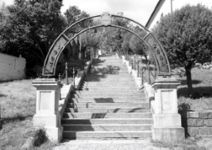
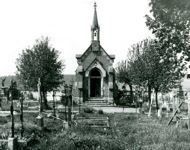
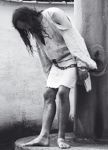
Kostel sv. Martina - z historických památek města Rosice jsem si vybral románský kostel sv. Martina, jenž je nejstarší stavbou ve městě.
Některé další rosické památky:
Rosické schody – vznikly mezi lety 1907 a 1908 (zde se zdroje rozcházejí), vedou z Pendrova až na Palackého náměstí. Celkem má žulové schodiště 152 schodů. V době svého vzniku však mělo 107 (105) schodů s 10-ti odpočívadly.
Pohřební kaple Rahnů - Novogotická kaple na hřbitově, původně hrobka místní rodiny Rahnů z roku 1894, je typologicky a stavebně hodnotná drobná sepulkrální architektura, spjata s dějinami regionu.
Pranýř hanby – místo, na němž byl odsouzený vystaven po jistou dobu za trest k veřejné potupě. Rosický pranýř se původně nacházel před starou obecní radnicí a byl využíván od 15. do 18. stol. Mezi lety 1729 až 1748 spadalo pod rosické právo i panství Veverské ( mimo Žebětín). Jakmile bylo r. 1752 rosické hrdelní právo zrušeno, byl pranýř přesunut na dvůr obecního domu. R. 1959 byl opraven a umístěn pod radnici, kde stojí dodnes.
Listing Virtuální keše jsem doplnil 28-mi historickými a současnými fotografiemi. Každý snímek obsahuje popis místa, případně úhel focení dle jednotlivých světových stran. Snímky usnadní orientaci v terénu a umožní nahlédnout do vnitřního prostoru památek , který není trvale přístupný. Popis také najdete ve fotoblocích (Blok 1-7)
První část
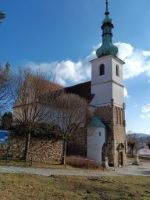
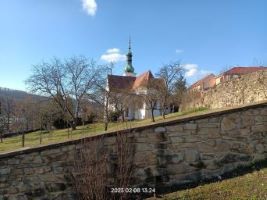

Kostel sv. Martina. Původně románský kostel pochází pravděpodobně z 12. století, počátkem 13. století již stál. Jednalo se o jednolodní kamennou stavbu s presbytářem a na západní straně s dodnes dochovanou věží. Původní vchod byl z jižní strany. Chrám byl goticky upraven a rozšířen o gotickou severní kapli, v období renesance byl rozšířen o jižní kapli. Barokní úpravy přinesly změnu přístupu do kostela ze západní strany přes věž a výměnu oken. V 18.století dostaly vnitřní prostory kostela nynější podobu – hlavní a boční oltáře, kazatelnu a ostatní výzdobu. V chrámu se nachází hrobky rodinných členů majitelů Rosického panství rodin Hausperských z Fanálu a Ugarte. V bočních kaplích jsou oltáře zasvěcené Panně Marii a u vchodu do kostela jsou umístěny sochy sv. Jana Nepomuckého a sv. Floriána. Kolem kostela se rozkládal hřbitov, jehož zbytky připomíná někdejší dětský hřbitov se sochou sv. Jana Nepomuckého.

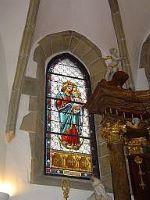
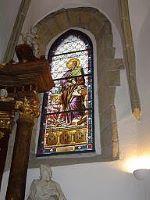
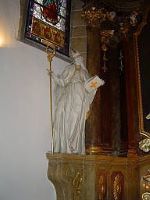
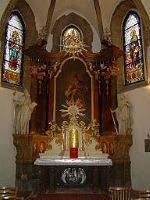
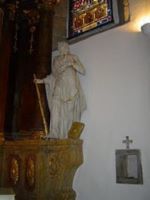
Originally a Romanesque church, it probably dates from the 12th century, at the beginning of the 13th century it was already standing. It was a single-nave stone building with a presbytery and a tower preserved to this day on the west side. The original entrance was from the south side. The church was Gothically modified and extended by the Gothic northern chapel, during the Renaissance it was extended by the southern chapel. Baroque alterations brought about a change of access to the church from the west side through the tower and the replacement of windows. In the 18th century, the interior of the church received its current appearance - the main and side altars, the pulpit and other decorations. In the church there are tombs of family members of the owners of the Rosický estate - Hausperský families from Fanál and Ugarte. In the side chapels there are altars dedicated to the Virgin Mary and at the entrance to the church there are statues of St. John of Nepomuk and St. Florian. There was a cemetery around the church, the remains of which are reminiscent of a former children's cemetery with a statue of St. Jan Nepomucký.
Ursprünglich eine romanische Kirche, stammt sie vermutlich aus dem 12. Jahrhundert, zu Beginn des 13. Jahrhunderts stand sie bereits. Es war ein einschiffiger Steinbau mit einem Presbyterium und einem bis heute erhaltenen Turm an der Westseite. Der ursprüngliche Eingang war von der Südseite. Die Kirche wurde gotisch umgestaltet und um die gotische Nordkapelle, in der Renaissance um die Südkapelle erweitert. Barocke Umbauten bewirkten einen veränderten Zugang zur Kirche von der Westseite durch den Turm und den Austausch von Fenstern. Im 18. Jahrhundert erhielt das Innere der Kirche sein heutiges Aussehen – Haupt- und Seitenaltäre, Kanzel und andere Verzierungen. In der Kirche befinden sich Gräber von Familienmitgliedern der Besitzer des Guts Rosický - Familien Hausperský aus Fanál und Ugarte. In den Seitenkapellen befinden sich Altäre, die der Jungfrau Maria geweiht sind, und am Eingang der Kirche befinden sich Statuen des hl. Johannes von Nepomuk und St. Florian. Um die Kirche herum befand sich ein Friedhof, dessen Reste an einen ehemaligen Kinderfriedhof mit einer Statue des hl. Jan Nepomucký.
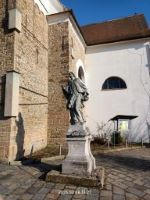
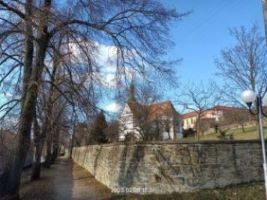
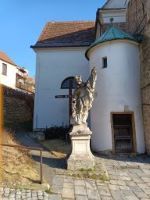
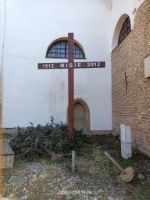
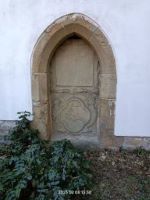

Druhá část
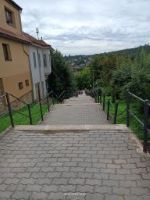
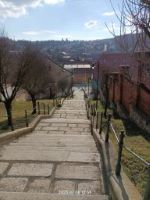
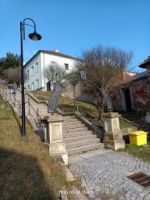
Rosické schody
Schody spojující Pendrov s Palackého náměstím postavil nákladem 11 000 zlatých roku 1907 místní stavitel Metoděj Rejthar. Nahradily předchozí kamenné schody z roku 1880. Při stavbě byla zabrána část farské zahrady. 105 schodů, které tvoří tři metry široké žulové kvádry, je opatřeno železným zábradlím.
Schodiště z Pendrova na náměstí vedlo ještě po druhé světové válce pouze k úrovni školy. Bylo však lemováno spletí okrasných keřů a stromů, které v mnoha místech tvořily nad schody klenbu. Dalších 55 betonových schodů bylo zhotoveno v roce 1954 stavebním družstvem Stavodruž Rosice. Schodiště muselo být několikrát opravováno, naposledy v roce 2000. Při této poslední rekonstrukci provedli žáci základní školy výsadbu zeleně.
Rosice Stairs
The stairs linking Pendrov with Palackého náměstí were build in 1907 at the cost of 11,000 florins by a local constructor Metoděj Rejthar. They replaced previous stone stairs from 1880. The construction seized a part of the presbytery garden. 105 stairs, each formed by a 3-meters-wide granite block, are equipped with iron rail. Shortlyafter the World War Two, led the stairs from Pendrov to the square only to the level of the school. They were,however, lined with alabyrinth of bushes and trees that often formed an arch above them. Additional 55 concretestairs were built in 1954 by a construction cooperative Stavodruž Rosice. The stairs had to be repaired several times. During the last reconstruction in 2000, pupils from Rosice elementary school planted new verdure.
Rosicer Treppe
Die Treppe, die den Stadtteil Pendrov mit dem Palacký – Platz verbinden, wurden zum Preis von 11 000 Goldtalern 1907 von dem Ortsbaumeister Metoděj Rajthar gebaut. Sie ersetzt vorige steinerne Treppe aus dem Jahr 1880. Beim Bau wurde ein Teil des Pfarrgartens eingenommen. 105 Stufen, die 3 Meter breite Stufen aus Granit bilden, sind mit dem eisernen Geländer besorgt. Die Treppe aus Pendrov zum Stadtplatz führte noch nach dem Zweiten Weltkrieg nur zum Schulgebiet. Sie wurde aber durchZiersträuche und – bäume eingefasst, die an vielen Stellen ein Gewölbe über den Treppen bildeten. Weitere 55 Betonstufen wurden 1945 von der Baugenossenschaft Stavodruž hergestellt. Die Treppe musste mehrmals renoviert werden, das letztemal im Jahre 2000. Bei dieser letzten Rekonstruktion wurde das Anpflanzen der Grüne von den Grundschuleschülern durchgeführt.
Třetí část
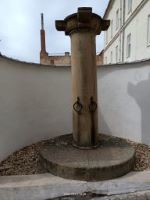
Pranýř – sloup hanby
Pranýř hanby sloužil hrdelnímu právu v 15. až 18. století. Před popravou postavili odsouzence k pranýři a uvázali ke kruhům. Zatknout zločince, vsadit do šatlavy a vyslýchat jej, popřípadě donutit k přiznání mučením spadalo do povinností rychtáře. Pranýř se nacházel před starou obecní radnicí.
Právo útrpné rušily postupně dekrety Marie Terezie a Josefa II., v Rosicích hrdelní soud skončil k roku 1752. V následujících letech byl pranýř – sloup hanby zbořen a od té doby ležely jeho trosky na dvoře obecního domu č. p. 45, kde měl upadnout v zapomnění lidu.
Na svém místě stojí od roku 1959, aby kolemjdoucím připomínal osudy odsouzených, kteří bývali často krutě trestáni mnohdy jen za malé provinění.
Pillory – Whipping Post
The pillory served Rosice capital law in fifteenth to eighteenth centuries. Before an execution, a convict was mounted at the pillory and tied to the rings. In charge of arresting a criminal, imprisoning and interrogating, or actually torturing a confession from them was a bailiff. The pillory used to stand in front of the old town hall. Capital courts were gradually abolished by decrees of Maria Theresa and Joseph II.,and Rosice capital court was disestablished in 1752. The whipping post was torn down in the following years and its ruins rested in the court of the house number 45, where it was supposed to wash away. The pillory, being a historic relic of regional importance, lay in the court of the house for more than one and half centuries. It was repaired due to the town council and it has rested in its current location since 1959 to remind the passers-by of the fate of delinquents, who were
very often punished for just a small trespass. Pranger – eine
Schandsäule
Der Pranger diente dem Blutgericht von 15. bis 18. Jahrhundert. Vor der Hinrichtung wurde der Verurteilte zum Pranger aufgestellt und zu den eisernen Ringen festgebunden. Einen Verbrecher festnehmen, ihn in den Kotter stecken und ihn verhören, beziehungsweise durchs Foltern zum Geständnis bewegen, war eine Pflicht des Gemeinderichters. Der Pranger stand vor dem alten Gemeinderathaus. Die Blutgerichte wurdenallmählich durch Maria Theresia und Joseph II.–Dekrete abgeschafft. Das Blutgericht in Rosice endete mit dem Jahr 1752. In den nächstenJahren war der Pranger – die Schandsäule – abgerissen. Seit dieser Zeit lagen seine Trümmer im Hof des Gemeindehauses Nr. 45, wo er inVergessenheit des Volkes geraten sollte. Anderthalb Jahrhunderte lag der Pranger in Rosice als ein historisches Denkmal des Brünner Bezirks im Gemeindehaushof. Dank dem Rosicer Stadtrat wurde er renoviert. Auf seinem heutigen Platz steht er seit 1959, damit er die Passanten auf die Schicksaale der Übeltäter aufmerksam macht, die oft grausam gestraft wurden, oft für nur einen kleinen Verstoß.
Čtvrtá část


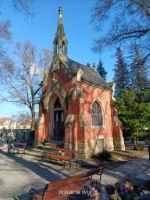
Kaple s rodinnou hrobkou
Kaplička s rodinnou hrobkou je dominantou rosického hřbitova. Roku 1894 ji nechal postavit u stavitele Augusta Prokopa majitel rosických dolů Jindřich Rahn, a to nákladem 7000 zlatých. V současnosti se před ní konají pohřební obřady. V nedávné době byla kaple zrekonstruována.
Poblíž kaple se nachází velký rodinný hrob rodiny Rahnů, významné rodiny, ke které patří původce výstavby železnice z Brna do Zastávky Antonín Rahn, zakladatel rosické kroniky a vynikající lékař Karel Rahn, vyznamenaný roku 1871 za zásluhy nebo Terezie Rahnová, která v roce 1858 věnovala prostředkyna zakoupení věžních hodin na rosickou radnici.
Chapel with the Family Crypt
The chapel with the family crypt is a dominant feature of Rosice cemetery. The owner of Rosice mines Jindřich Rahn had it built by architect August Prokop in 1894 at the cost of 7,000 florins. The chapel has recently been reconstructed and it has been utilized for burial services. There is a family crypt of the Rahns family located near the chapel. Among the members of this prominent family was the initiator of the construction of the railway from Brno to Zastávka Antonín Rahn, the founder of the Rosice chronicle and an excellent doctor Karel Rahn, who was in 1871 honoured fo merits, and Terezie Rahnová, who in 1858 sponsored the purchase of the tower clock for Rosice town hall.
Kapelle mit Familiengruft
Die Kapelle mit der Familiengruft bildet die Dominante des Rosicer Friedhofs. Im Jahre 1894 ließ sieder Besitzer der Rosicer Bergwerke Jindřich Rahn beim Baumeister August Prokop erbauen, und zwar zum Preis von 7000 Goldtalern. In der Gegenwart finden vor der Kapelle Bestattungen statt. Vor kurzer Zeit wurde die Kapelle rekonstruiert.
In der Nähe der Kapelle befindet sich das große Familiengrab der Familie Rahn, einer bedeutenden Familie, zu der der Initiator des Eisenbahnbaus von Brünn nach Zastávka Antonín Rahn, der Gründer der Rosicer Chronik und ein hervorragender Arzt Karel Rahn, der für seine Verdienste 1871 ausgezeichnet wurde, oder Terezie Rahn, die 1858 die finanziellen Mittel für den Kauf der Turmuhr für das Rosicer Rathaus stiftete.
Podmínky pro uznání logu
Chci, abyste si prošli všechna památná místa, která jsou uvedená v této keši. Vaším úkolem bude vyfotit alespoň jednu fotografiií v každé části, která je pojmenovaná souřadnicemi v trasových bodech!!! Celkem čtyři snímky nebo jednu koláž se snímky ze čtyřech určených míst. Nejlépe vždy vyfoť sebe, nebo svou GPS či CWG. Trasu si naplánuj podle svých představ a rozhodnutí. Ta nejkratší by měla mít okolo 1,5 km.
Poznámka: Prosím, ověřte si před odlovem této Virtual Reward 3.0 aktuální provozní dobu přístupnosti jednotlivých geoobjektů. Jená se zejména o místní hřbitov (https://www.rosice.cz/hrbitov-hroby)
Conditions for logo recognition
I want you to go through all the memorable places that are listed in this cache. Your task will be to take at least one photo in each section, which is named by the coordinates in the waypoints!!! A total of four images or one collage of images from the four designated locations. It's best to always take a picture of yourself or your GPS or CWG. Plan the route according to your ideas and decisions. The shortest should be around 1.5 km.
Note: Please check the current operating hours of accessibility of individual geoobjects before catching this Virtual Reward 3.0. It is mainly about the local cemetery (https://www.rosice.cz/hrbitov-hroby)
Hinweis: Bitte überprüfen Sie die aktuellen Betriebszeiten der Zugänglichkeit einzelner Geoobjekte, bevor Sie sich diese virtuelle Belohnung 3.0 sichern. Es geht hauptsächlich um den örtlichen Friedhof
(https://www.rosice.cz/hrbitov-hroby)